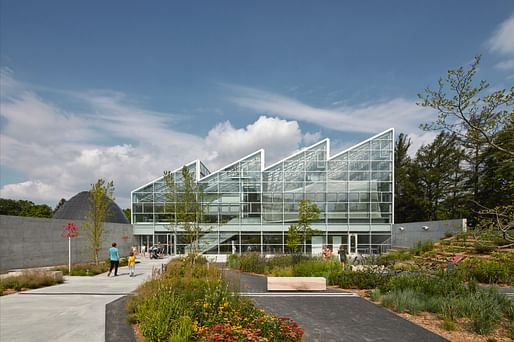

An architectural team composed of Kuehn Malvezzi, Pelletier de Fontenay, and Jodoin Lamarre Pratte architects has been awarded the Grand Prix d’excellence en architecture from the Ordre des architectes du Québec for their Metamorphosis of the Montreal Insectarium.
The project underwent a seven-year design and construction period before opening on April 13th, 2022. Featuring hundreds of insect species and detailed displays, the center also holds an immersive sensory labyrinth experience, a pollinator garden, creative workshops, and production areas.
The insectarium is part of the wider Space for Life complex, which is the largest natural science museum complex in Canada. The insectarium is located alongside the Biodôme and the Jardin botanique, and aims to “transform the public’s relationship with insects through an innovative architectural and museological approach.
“The concept of biophilia takes on its fullest meaning in this Space for Life institution in Montreal,” the Grand Prix jury said about the scheme. “The glass volume, with its contemporary silhouette, and the base of earth and lush vegetation that it covers, offers an immersive journey that invites the visitor not only to discover insects but to adopt their point of view on their environment.”
Three structures define the center’s exterior, aimed at signifying a light-touch construction process that integrates into the pre-existing landscape of the botanical garden. The walled Pollinator Garden serves as a relaxing and welcoming space, which slopes down to a greenhouse containing a central hall and living environments for live insects. Beyond the greenhouse, a planted mound “erupts from the surface as a cocoon-like dome that contains the Insectarium's collection within.”
Entering the main hall, visitors encounter the Labyrinth through a curved, descending pathway with sloping walls. According to the team, the path is designed to “destabilize our perception; to signal a departure from familiar spatial environments and the entrance to an underground labyrinth of six Perceptual Alcoves.” The six rooms within the Labyrinth are designed to disorientate human senses and mimic the sight, sound, and movement of insects.
Beyond the Labyrinth, visitors encounter living insects through the Tête-à-tête Gallery where six bespoke viewing boxes provide up-close views of the different species. Meanwhile, the Insectarium’s collection is housed and displayed in a dramatic, 32-foot-high Domed Hall that erupts through the earth as a planted mound. On the minimal, shotcrete interior, a wall of 72 framed displays shows the museum’s extensive and unique collection of preserved insects unfolding across two horizontal bands.
The Insectarium incorporates several bioclimatic considerations, including the stepped shape of the greenhouse volume being naturally orientated towards the south to increase the area of sun exposure. Meanwhile, underground areas take advantage of the natural thermal mass.
No Comments
Block this user
Are you sure you want to block this user and hide all related comments throughout the site?
Archinect
This is your first comment on Archinect. Your comment will be visible once approved.